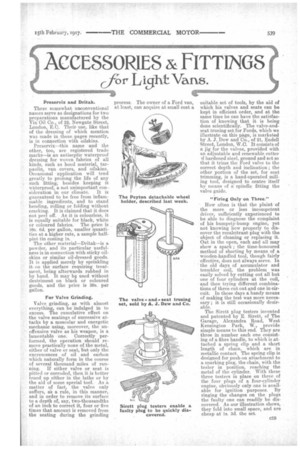ACCESSORIES a FITTINGS c jOr Light Vans.
Page 19

If you've noticed an error in this article please click here to report it so we can fix it.
Preservix and Dritak.
These somewhat unconventional names serve as designations for two preparations manufactured by the Vix Oil Co., of 22, Newgate Street, London, E.C. Their use, like that of the dressing of which mention was made in these pages recently, is in connection with oilskins.
Preservix—this name and the other, too, are registered trade marks—is an antiseptic waterproof dressing for woven fabrics of all kinds, such as hood material, tarpaulin, van covers, and oilskins. Occasional application will tend greatly to prolong the life of any such fitting, besides keeping it waterproof, a. not unimportant consideration in our climate. It is guaranteed to be free from inflammable ingredients, and to stand bending, rolling or folding without cracking. It is claimed that it does not peel off. As it is colourless, it is equally suitable for black, white or coloured fabrics. The price is 10s. 6d. per gallon, smaller quantities at a higher rate, a sample halfpint tin costing is.
The other material—Dritak—is a powder, and its particular usefulness s in connection with sticky oilskins or similar oil-dressed goods. It is applied merely by sprinkling it on the surface requiring treatment, being afterwards rubbed in by hand. It may be used without destriment on black or coloured goods, and the price is 30s. per gallon.
For Valve Grinding.
Valve grinding, as with almost everything, can be indulged in to excess. The cumulative effect on the valve seatings of successive attacks by a muscular and energetic mechanic using, moreover, the unoffensive valve as his weapon, is a lamentable one. Correctly performed, the operation should remove practically none of the metal, either of valve or seat, but only the excrescences of oil and carbon which naturally form in the course of several thousand miles of running. If either valve or seat is pitted or corroded, then it is better trued up either in the lathe or by the aid of some special tool. As a matter of fact, the valve only suffers, as a rule, in this manner, and in order to remove its surface to a depth of, say, two-thousandths of an inch to correct it, four or five times that amount is removed from the seating during the grinding
process. The owner of a Ford van, at least, can acquire at small cost a
suitable set of tools, by the aid of which his valves and seats can be kept in efficient order, and at the same time he can have the satisfaction of knowing that it is being done scientifically. The valve-andseat trueing set for Fords, which we illustrate on this page, is marketed by A. J. Dew and Co., of 21, Endell Street, London, W. C. It consists of a jig for the valves, provided with an adjustable and renewable cutter If hardened steel, ground and set so that it trims the Ford valve to the correct depth and inclination ; the other portion of the set, for seat trimming, is a hand-operated milling tool, designed to centre itself by means of a spindle fitting the valve guide.
"Firing Only on Three."
How often is that the plaint of the more or less incompetent driver, sufficiently experienced to be able to diagnose the complaint of his bumpety-bump engine, yet not knowing how properly to discover the recalcitrant plug with the object of cleaning or replacing it. Out in the open, each and all may show a spark ; the time-honoured method of shorting by means of a wooden-handled tool, though fairly effective' does not always serve. In the old days of accumulator and trembler coil, the problem was easily solved by cutting out all but one of four cylinders at the coil, and then trying different combinations of three cut out and one in circuit. In those days a handy means of making the test was more necessary; it is still occasionally desirable.
The Sirett plug testers invented and patented by E. Sirett, of The Garage, Alexandra Road, West Kensington Park, W., provide simple means to this end. They are three in number each one consisting of a fibre handle, to which is atta,ched a spring clip and a short length of chain, which are in metallic contact. The spring clip is designed for push-on attachment to a sparking plug, the chain, with the tester in position, reaching the metal of the cylinder. With these three testers in place on three of the four plugs of a four-cylinder engine, obviously only one is available for ignition purposes. By ringing the changes on the plugs the faulty one can readily be discovered. As our illustration shows, they fold into small space, and are cheap at is. 3d. the set.






















